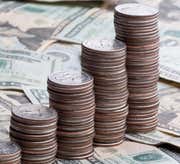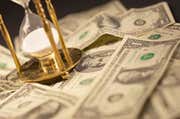By Stephen Simpson
The business cycle is the pattern of expansion, contraction and recovery in the economy. Generally speaking, the business cycle is measured and tracked in terms of GDP and unemployment – GDP rises and unemployment shrinks during expansion phases, while reversing in periods of recession. Wherever one starts in the cycle, the economy is observed to go through four periods – expansion, peak, contraction and trough.
Recession is typically used to mean a downturn in economic activity, but most economists use a specific definition of "two consecutive quarters of declining real GDP" for recession. By comparison, there is no formal definition of depression. While recessions have averaged around 10 months in length since the 1950s, the recovery/expansion phases have a much wider range of lengths, though around three years is relatively common.
The movement of the economy through business cycles also highlights certain economic relationships. While growth will rise and fall with cycles, there is a long-term trend line for growth; when economic growth is above the trend line, unemployment usually falls. One expression of this relationship is Okun's Law, an equation that holds that every 1% of GDP above trend equates to 0.5% less unemployment.
The relationship between inflation and growth is not as clear, but inflation does tend to fall during recessions and then increase through recoveries. (To learn more about the business cycle, see Recession: What Does It Mean To Investors?)
While the business cycle is a relatively simple concept, there is great debate among economists as to what influences the length and magnitude of the individual parts of the cycle, and whether the government can (or should) play a role in influencing this process. Keynesians, for instance, believe that the government can soften the impact of recessions (and shorten their duration) by cutting taxes and increasing spending, while also preventing an economy from "overheating" by increasing taxes and cutting spending during expansion phases.
In comparison, many monetarist economists disagree with the notion of business cycles altogether and prefer to look at changes in the economy as irregular (non-cyclical) fluctuations. In many cases, they believe that declines in business activity are the result of monetary phenomena and that active government inflation is ineffective at best and destabilizing at worst.
There are numerous other alternate theories on the business cycle and its causes/influences. Real business cycle theorists, for instance, believe that it is external shocks like innovation and technological progress that drive cycles, and that issues like excessive overcapacity can drive downturns. Other theorists suggest that excess speculation or the creation of excess levels of bank capital drive business cycles. (To learn more about the Keynesian theory, check out Can Keynesian Economics Reduce Boom-Bust Cycles?)
Macroeconomics: Unemployment
The business cycle is the pattern of expansion, contraction and recovery in the economy. Generally speaking, the business cycle is measured and tracked in terms of GDP and unemployment – GDP rises and unemployment shrinks during expansion phases, while reversing in periods of recession. Wherever one starts in the cycle, the economy is observed to go through four periods – expansion, peak, contraction and trough.
Recession is typically used to mean a downturn in economic activity, but most economists use a specific definition of "two consecutive quarters of declining real GDP" for recession. By comparison, there is no formal definition of depression. While recessions have averaged around 10 months in length since the 1950s, the recovery/expansion phases have a much wider range of lengths, though around three years is relatively common.
The movement of the economy through business cycles also highlights certain economic relationships. While growth will rise and fall with cycles, there is a long-term trend line for growth; when economic growth is above the trend line, unemployment usually falls. One expression of this relationship is Okun's Law, an equation that holds that every 1% of GDP above trend equates to 0.5% less unemployment.
The relationship between inflation and growth is not as clear, but inflation does tend to fall during recessions and then increase through recoveries. (To learn more about the business cycle, see Recession: What Does It Mean To Investors?)
While the business cycle is a relatively simple concept, there is great debate among economists as to what influences the length and magnitude of the individual parts of the cycle, and whether the government can (or should) play a role in influencing this process. Keynesians, for instance, believe that the government can soften the impact of recessions (and shorten their duration) by cutting taxes and increasing spending, while also preventing an economy from "overheating" by increasing taxes and cutting spending during expansion phases.
In comparison, many monetarist economists disagree with the notion of business cycles altogether and prefer to look at changes in the economy as irregular (non-cyclical) fluctuations. In many cases, they believe that declines in business activity are the result of monetary phenomena and that active government inflation is ineffective at best and destabilizing at worst.
There are numerous other alternate theories on the business cycle and its causes/influences. Real business cycle theorists, for instance, believe that it is external shocks like innovation and technological progress that drive cycles, and that issues like excessive overcapacity can drive downturns. Other theorists suggest that excess speculation or the creation of excess levels of bank capital drive business cycles. (To learn more about the Keynesian theory, check out Can Keynesian Economics Reduce Boom-Bust Cycles?)
Macroeconomics: Unemployment
Related Articles
-
 Insights
InsightsRecessions and Depressions Aren't So Bad
Downturns like depressions and recessions are a natural part of the economic cycle and can actually provide some benefits. -
 Insights
InsightsIs a Recession Coming?
Even as a number of economic indicators look good, global conditions and inflation levels point to the imminence of another recession. -
 Investing
InvestingSector rotation: Knowing the essentials
Learn how the market signals impending economic cycles and sector performance during each stage. Find out how investors can use sector rotation for profit. -
 Investing
InvestingUnderstanding Market and Full Risk Cycles
Investor need to understand the four stages the markets tend to experience. -
 Insights
InsightsCan Keynesian Economics Reduce Boom-Bust Cycles?
Learn about this famous British economist's proposed solution to a widespread economic problem. -
 Insights
Insights6 Factors That Point to Global Recession in 2016
We may be on the verge of another global recession. -
 Managing Wealth
Managing WealthTop 6 Recession Investing Myths
Find out the truth about recessions and how they impact your portfolio. -
 Insights
InsightsWill Your Net Worth Be Affected By A Recession?
Here's a look at how a potential recession could impact your net worth in a negative way.



